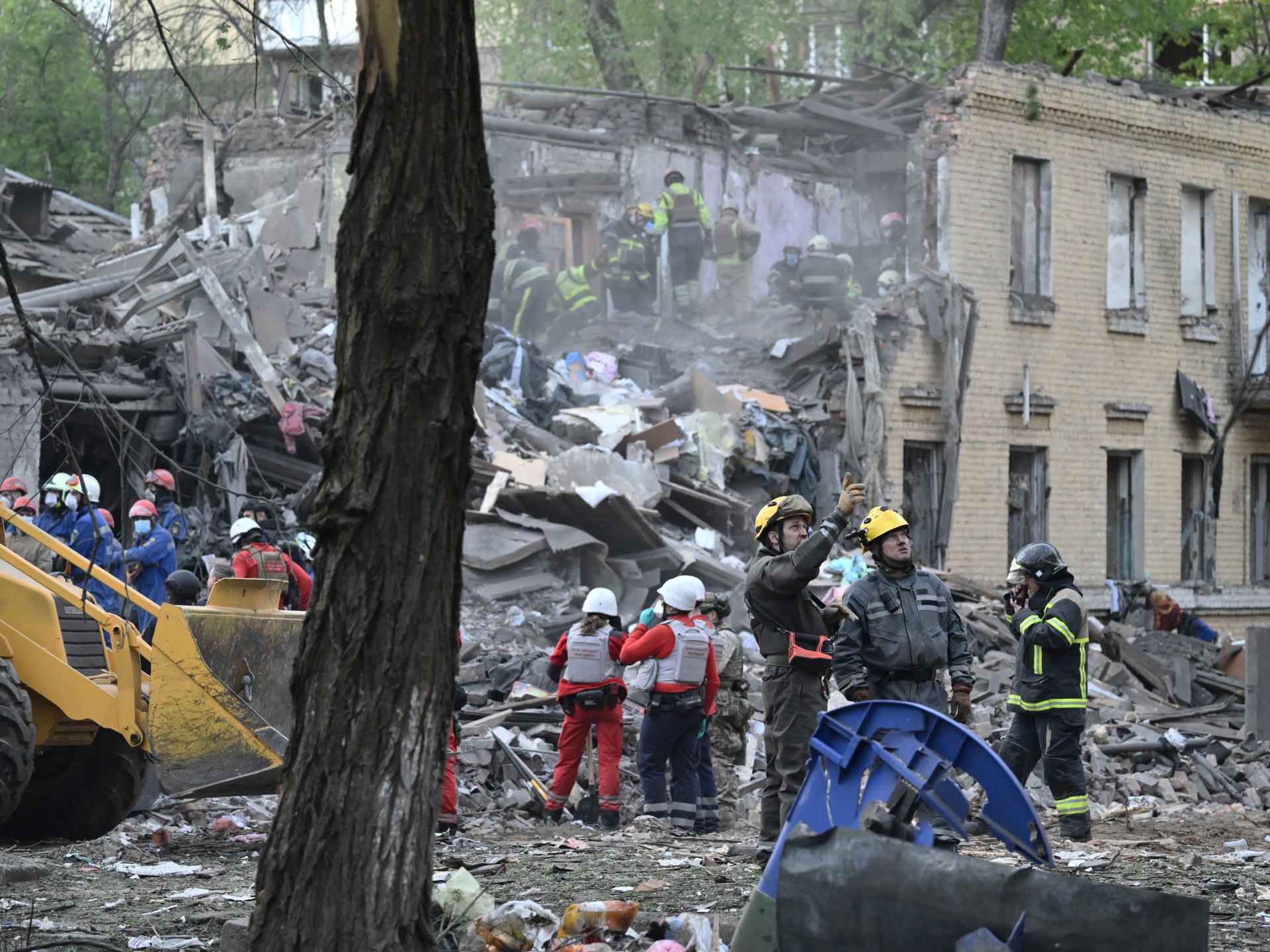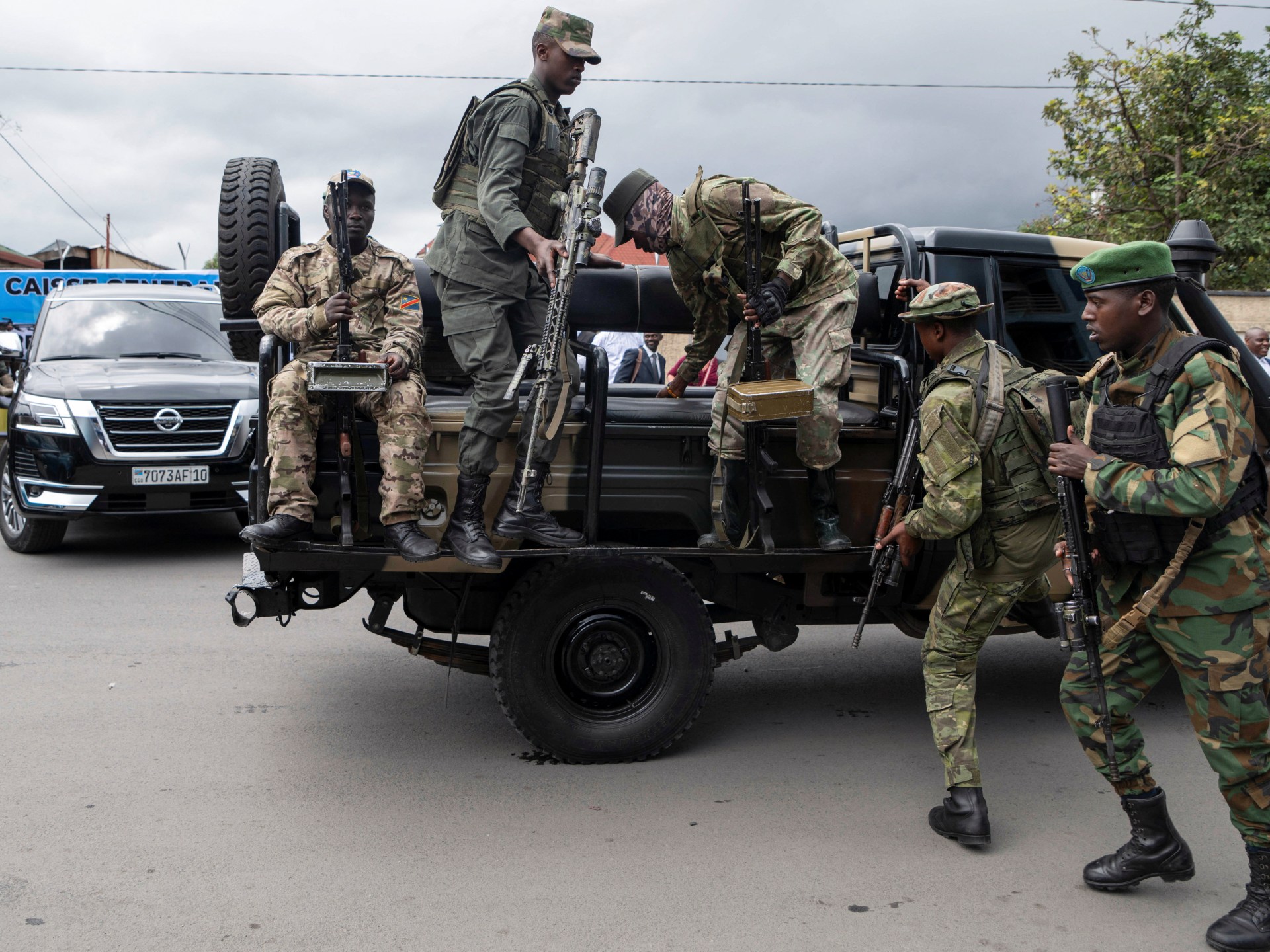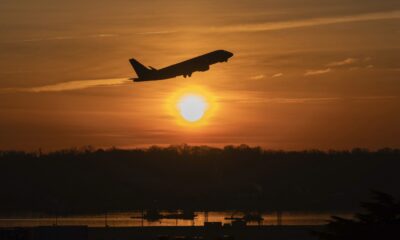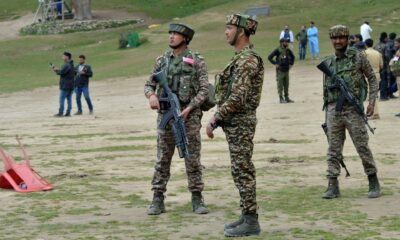Conflict Zones
Russia kills 8 civilians in overnight attack on Ukraine’s capital Kyiv | Russia-Ukraine war News

A Russian missile attack on Ukraine’s capital Kyiv has killed at least eight people and injured dozens in one of the deadliest strikes since Russia launched its full-scale invasion more than three years ago.
Loud blasts sounded over the city overnight on Thursday after air raid sirens rang out, warning residents to head to shelters before the Russian missile attack.
While Ukraine has been battered by Russian aerial attacks throughout the war, strikes on Kyiv, which has better air defences than other cities, are less common.
Through the night, rescue workers were going through the rubble of destroyed buildings and tackling blazes in apartment blocks.
“Russia has launched a massive combined strike on Kyiv,” Ukraine’s State Emergency Service said on Telegram, adding that eight people were killed and dozens more wounded.
At least 42 people were hospitalised, including six children, it added.
Russia also launched a large-scale attack on the northeastern city of Kharkiv overnight. Kharkiv Mayor Igor Terekhov said at least seven missiles had been fired at the city.
“One of the most recent strikes hit a densely populated residential area … Two people were injured there. The inspection of the sites of enemy strikes is under way,” Terekhov said, urging the city’s residents to “be careful”.
Separately, Russia’s Ministry of Defence reported downing 87 Ukrainian drones overnight, including 45 over Crimea, a Ukrainian peninsula that was annexed by Moscow in 2014.
Ceasefire efforts
The attacks throw yet more doubt on already fraught US efforts to get Russia and Ukraine to agree to a ceasefire, hours after President Donald Trump lashed out at Ukrainian President Volodymyr Zelenskyy for refusing to accept Moscow’s occupation of Crimea as a condition for peace.
Russian President Vladimir Putin has not yet responded to Zelenskyy’s offer to completely halt air attacks on civilian targets, and last month rejected a US-Ukrainian call for a full and unconditional ceasefire.
“Putin shows only a desire to kill,” Andriy Yermak, one of Zelenskyy’s top aides, said as Russia unleashed its attack overnight. “The attacks on civilians must stop,” he added.
Russia has launched a number of its most deadly aerial attacks at Ukraine over the last month – defying Trump’s push to bring about a rapid end to the bloodshed.
A ballistic missile attack on the centre of the northeastern city of Sumy killed at least 35 people on April 13, while an attack on Zelenskyy’s hometown of Kryvyi Rig in early April killed at least 19.
The Ukrainian leader had on Wednesday called for an “immediate, full and unconditional ceasefire”.
“Stopping the killings is the number one task,” Zelenskyy said on social media, as his top officials met European and US officials in London.
Hours before the attack on Thursday, Trump had said a peace deal was “very close” – and closed with Moscow – but accused Zelenskyy of being “harder” to negotiate with.
The Ukrainian president’s refusal to accept US terms for ending the conflict “will do nothing but prolong the ‘killing field’”, Trump said.
“I think we have a deal with Russia. We have to get a deal with Zelenskyy,” Trump told reporters. “I thought it might be easier to deal with Zelenskyy. So far it’s been harder.”
Reporting from Kyiv, Al Jazeera’s Zein Basravi said the Ukrainians he spoke to following Thursday’s attack “are incredibly frustrated”.
When asked about Trump’s seven-point peace plan, “many people here don’t even want to listen to the question. They say that Trump should keep quiet,” he said.
“People here are frustrated, they are angry, they are tired of what they describe as Russian lies and they are tired of what they describe as this bullish American government trying to force them into making concessions while they still experience ongoing air attacks on a daily basis,” Basravi reported.
Conflict Zones
How will Harvard and other universities survive Trump’s funding cuts? | Conflict News

On Monday, Harvard University sued US President Donald Trump’s administration to halt the freezing of $2.3bn in federal funding for the institution. The funding freeze came amid US government efforts to crack down on student protesters and pressure universities into dropping diversity, equity and inclusion programmes.
On March 10, the US Department of Education announced it had sent letters to 60 higher education institutions, warning them of “enforcement actions” if they did not protect Jewish students on campus as stipulated in the Title VI of the Civil Rights Act. The letters also quoted Secretary of Education Linda McMahon saying, “US colleges and universities benefit from enormous public investments funded by US taxpayers. That support is a privilege and it is contingent on scrupulous adherence to federal anti-discrimination laws.”
Shortly after, the Trump administration began freezing federal funding for some of the country’s top institutions, threatening research that universities say is critical for medical and scientific advancement.
In particular, the Trump administration is targeting institutions where students participated in pro-Palestine protests last year, alleging that the student protesters spread anti-Semitic sentiment on campus.
A day after Harvard filed its lawsuit, leaders and representatives of more than 200 American universities issued a joint statement accusing the Trump administration of political interference. The statement was signed by presidents and directors of some of the top-tier institutes in the country, including Princeton, Brown, Harvard, Columbia, Northwestern University and Pomona College.
So, what is going on in terms of federal funding on US campuses, and can universities survive these cuts?
Why is Harvard suing the US government over funding?
On April 11, the US Department of Education, Department of Health and Human Services, and the General Services Administration co-signed a letter to Harvard claiming that “Harvard has in recent years failed to live up to both the intellectual and civil rights conditions that justify federal investment.”
The letter made a series of demands of the university, including that the institution end all affirmative action in faculty hiring and student admissions, and that it change its admissions criteria to exclude international students “hostile to the American values”, including “students supportive of terrorism or anti-Semitism”. This was a follow-up to a separate letter the government had sent Harvard on April 3, demanding that the university reform any academic departments deemed to be fuelling “antisemitic harassment”. These departments, the letter said, “must be reviewed and necessary changes made to address bias, improve viewpoint diversity, and end ideological capture”.
In response, Harvard rejected the demands, saying that while some demands were aimed at targeting anti-Semitism, “the majority represent direct governmental regulation of the ‘intellectual conditions’ at Harvard.”
Hours after Harvard rejected the demands, an Education Department task force to tackle anti-Semitism released a statement announcing that $2.3bn in federal funding to the university had been frozen.
Harvard’s president, Alan Garber, and fellows of Harvard College have now filed a lawsuit (PDF) in the US District Court in Massachusetts against leaders of the US Department of Education, Department of Health and Human Services, General Services Administration, Department of Energy, Department of Defense, National Science Foundation and National Aeronautics and Space Administration.
In a statement issued on Monday, Garber wrote: “We filed a lawsuit to halt the funding freeze because it is unlawful and beyond the government’s authority.”
The suit says that “the federal Government has launched a broad attack on the critical funding partnerships” which make it possible for Harvard and other American universities to carry out “invaluable research” in the fields of medicine, engineering and artificial intelligence (AI) which is crucial for finding solutions for space travel and for the diagnosis and treatment of diseases such as Parkinson’s, Alzheimer’s and cancer, among other things.
The lawsuit also alleges that the funding freeze is unlawful because it infringes on First Amendment rights, which guarantee the freedom of speech.
“This case involves the Government’s efforts to use the withholding of federal funding as leverage to gain control of academic decision-making at Harvard,” the lawsuit states.
The Tuesday joint statement co-signed by hundreds of American university leaders states: “We will always seek effective and fair financial practices, but we must reject the coercive use of public research funding.”
How much money could Harvard and other universities lose?
The frozen federal funds to Harvard include $2.2bn in grants and $60m in contracts. However, more money is at stake. In March, the Trump administration announced that it would review $9bn of funding to Harvard.
The administration has also threatened to revoke Harvard’s tax exempt status and its ability to enrol foreign students. In the Monday statement, Garber also wrote that the Trump administration has considered taking steps to freeze an additional $1bn in grants.
In February, the Trump administration froze $400m of funding to Columbia University, which emerged as the epicentre of pro-Palestine campus protests in 2024. The government cited what it called the institution’s “failure to protect Jewish students from anti-Semitic harassment”.
On March 19, Trump froze more than $175m in federal funding to his alma mater, the University of Pennsylvania, citing the allowance of transgender women to play women’s sports.
How else is university funding being targeted?
Some universities have reported receiving “stop work” orders, which are instructions to suspend all work on specific research projects supported by public funding.
“American universities receive two main funding sources from the federal government. The first is financial aid for students, which flows to thousands of colleges. The second is research funding, which is heavily concentrated at about 200 universities,” Robert Kelchen, a professor and department head at the Department of Educational Leadership and Policy Studies at the University of Tennessee, Knoxville, told Al Jazeera.
“The American government has relied on universities to conduct research to benefit the country since World War II, and universities have built an infrastructure around that. The magnitude of American research funding has been unmatched around the world during this period,” said Kelchen.
Cornell University said it had received more than 75 “stop work” orders from the US Department of Defense, according to a statement released by Cornell President Michael I Kotlikoff and other university leaders on April 8.
The orders sent to Cornell relate to “research into new materials for jet engines, propulsion systems, large-scale information networks, robotics, superconductors, and space and satellite communications, as well as cancer research”, the university said.
The statement did not specify the amount of federal funding the projects subject to stop work orders were receiving. It also did not say why the government had issued these orders.
Northwestern University has also received stop work orders relating to roughly 100 federal grants, the university’s President Michael Schill and Chair of Board of Trustees Peter Barris wrote in a statement on Northwestern University’s website on April 17.
Earlier in April, US media outlets reported that the Trump administration had separately frozen more than $1bn in federal funding to Cornell University and $790m in funding to Northwestern University. The New York Times and CNN both claimed that an unnamed White House official had confirmed these funding freezes. “The money was frozen in connection with several ongoing, credible, and concerning Title VI investigations,” the official was quoted by CNN as saying.
However, both Cornell and Northwestern say they have not received notification of these funding freezes.
How much money of their own do universities have?
Many universities have sizeable endowment funds from which they can draw income each year to support research projects, scholarships and other expenses. An endowment is a series of funds or assets donated to a university to ensure that the institution is financially sustained in the future. Charitable donations from alumni, other donors and companies make up a huge part of endowments.
Harvard’s endowment was worth approximately $53.2bn in the 2024 fiscal year – the largest of any university. More than one-third of the research at Harvard is funded directly by the university, according to Harvard’s website.
Columbia’s endowment was $14.8bn for the fiscal year ending in June 2024. Cornell’s endowment was about $10.7bn in the fiscal year ending in June 2024. Northwestern University’s endowment amounted to approximately $14.3bn in 2024. University of Pennsylvania’s endowment was $22.3bn as of June 2024.
Some universities will be able to fall back on these endowments if federal funding freezes remain in place. “Universities typically spend about 5 percent per year out of their endowment, which provides funding for the Harvards of the world to make up for a loss of federal funding,” said Kelchen.
Endowments are subject to restrictions, however. “Endowment funds are heavily concentrated at a few dozen universities, and roughly three-fourths of all endowment funds are restricted for particular purposes,” Kelchen said, explaining that such purposes include student scholarships in very specific fields.
At Harvard, donors decide which programmes, departments and purposes 70 percent of the annual endowment distribution is spent on. Columbia’s website also states that the annual spending of the endowment is according to the wishes of the donors.
Universities have also seen a fall in the value of endowments. In 2024, Harvard’s donations dropped by $151m after some donors pulled funding from the university over the pro-Palestine protests and the university’s response to concerns about anti-Semitism on campus, according to an October 2024 report by the student-run newspaper, the Harvard Crimson.
How will universities respond to threats to government funding?
Kelchen said that a few research universities may be able to make it through a period of several years without federal funding.
In its April 17 statement, for example, Northwestern University’s leadership wrote that for now, the university will continue to fund the research projects that are subject to stop work orders from the government. “This support is intended to keep these projects going until we have a better understanding of the funding landscape.”
Most universities will not be able to afford to this. Some, therefore, are acceding to government demands.
After receiving its own list of demands from the government on March 13, Columbia, for example, accepted these demands on March 18 and introduced new policies on campus. These new policies require protesting students to present their university identification if asked to do so. They also prohibit face masks intended to conceal a person’s identity. However, face coverings are still allowed for religious or medical reasons. Columbia also hired 36 security officers who have special powers to arrest students, and the university continues to rely on New York police for additional security assistance.
Some universities will try to seek other sources of funding, experts say.
“Universities have been trying to diversify funding sources for years. The two most likely sources are increasing enrolment [to get more tuition dollars] and trying to generate more donations,” said Kelchen.
“Some universities have the physical capacity to increase enrolment, while others do not. And universities are hoping for a rush of donations to help them get through a difficult time,” said Kelchen.
Conflict Zones
India and Pakistan near strategic standoff after Pahalgam attack in Kashmir | Armed Groups News

Islamabad, Pakistan – Pakistan threatened to suspend its participation in all bilateral agreements with India, including the 1972 Simla Agreement, on Thursday in a retaliatory move after India said it would suspend its own participation in the Indus Water Treaty and close the land border the day before.
The Simla Agreement was a peace accord signed by the two countries a few months after Bangladesh became independent from Pakistan.
In a communique issued following a meeting of the National Security Committee (NSC), Pakistan’s top civil-military decision-making body, Pakistan has warned India that any disruption of its water supply would be considered “an act of war”, adding that it was prepared to respond, “with full force across the complete spectrum of national power”.
The NSC meeting, which took place on Thursday in Islamabad, was led by Pakistani prime minister Shehbaz Sharif, alongside other government officials and chiefs of its military forces.
The NSC statement mirrored actions announced by India on Wednesday, and included the closure of the Wagah Border Post with “immediate effect”, the suspension and cancellation of SAARC visas for Indian nationals (excluding Sikh pilgrims), the designation of Indian defence advisors as personae non grata in Pakistan, a reduction in the staff of the Indian High Commission, the closure of Pakistani airspace to Indian airlines, and the suspension of all trade with India.
The moves follow India’s response to Tuesday’s attack on tourists in Indian-administered Kashmir, which resulted in the deaths of at least 26 people.
Following a cabinet meeting on Wednesday, chaired by Indian Prime Minister Narendra Modi, the Indian government announced a series of measures, including the suspension of its part in the 65-year-old Indus Waters Treaty, a pact that allows both countries to irrigate their agricultural lands.
In a media conference, Indian Foreign Secretary Vikram Misri also announced the closure of the border with Pakistan, slashed the number of Indian diplomatic staff in Pakistan, ordered Pakistani citizens under the SAARC scheme to leave the country within 48 hours, and expelled Pakistani military attaches posted in India. This response has been soundly interpreted as India blaming Pakistan for the attack in Kashmir.
The Himalayan territory of Kashmir has been a flashpoint between the two countries since they gained independence from British rule in 1947, with each country controlling parts of Kashmir but claiming it in full. Since independence, the nuclear-armed neighbours have fought four wars, three of them over Kashmir.
Pakistan’s Foreign Minister Ishaq Dar, who also serves as deputy prime minister, called the Indian steps “immature and hasty” in a television interview on Wednesday night, .
“India has not given any evidence [of Pakistani involvement in the attack].” They have not shown any maturity in their response. This is not a serious approach. They started creating hype immediately after the incident,” said Dar, who also serves as deputy prime minister.
Defence Minister Khawaja Asif also rejected India’s implication of Pakistani involvement in the attack.
“India’s allegation against Pakistan for the Pahalgam incident is inappropriate. There should be no ambiguity that we strongly condemn terrorism,” Asif said.
 ‘Ready for Indian misadventure’
‘Ready for Indian misadventure’
Following the Pahalgam attack, commentary in Indian media and talk among the political leadership has leaned towards launching a military strike on Pakistan, drawing parallels with the 2019 Balakot strikes.
In February 2019, following an attack in Pulwama, Indian-administered Kashmir, in which more than 40 Indian soldiers were killed, India launched air strikes in Balakot, northern Pakistan, targeting what it called “militant hideouts”.
Pakistan said the strikes only hit an uninhabited forest and responded with its own air strikes near Indian military targets, causing no casualties.
Both sides also deployed fighter jets and, in an aerial dogfight, an Indian aircraft was shot down. Its pilot, Abhinandan Varthaman, was captured but released two days afterwards.
Indian Defence Minister Rajnath Singh also hinted at a “strong response”, reiterating India’s “zero tolerance” policy on terrorism.
“We will not only reach out to those who have carried out this incident. We will also reach out to those who, sitting behind the scenes, have conspired to commit such nefarious acts on the soil of India,” he said, at the Marshal of the Air Force Arjan Singh Memorial Lecture in New Delhi on April 23.
Analysts and security officials in Pakistan say they believe that Indian military action could now be possible, but said the country was “ready for any Indian misadventure”.
“We are maintaining a high level of alertness and vigilance, but unlike India, we don’t want to create any unnecessary hype by talking about our readiness,” a security source told Al Jazeera on condition of anonymity, as he has not been authorised to speak on the matter.
“India is wrong if it thinks there isn’t going to be any tit for tat. However, we are both nuclear-armed countries, and Indian aggression could lead to an irresponsible situation. Both of us should act carefully,” he added.
The official further questioned India’s allegation of Pakistani involvement, noting that the attack took place nearly 200km (124 miles) from the Line of Control, the de facto border between the two countries, and highlighted the presence of more than 500,000 Indian security personnel in the Kashmir valley.
He also pointed to the recent visit to India by United States Vice President JD Vance, who arrived in the country on Monday with his wife and two children for a four-day visit, taking in a meeting with Prime Minister Modi.
“How do you think this attack will serve Pakistan, especially with JD Vance being there?” he asked. “Could this attack lead to the liberation of Indian Kashmir? Why won’t Indian authorities take time to look inward and introspect? Will they ever accept their own security shortcomings?”

‘Fight-to-finish syndrome’
Past skirmishes have previously raised the spectre of war between the two countries, which together have a population exceeding 1.5 billion.
Asfandyar Mir, a security analyst specialising in South Asia, said Pakistan is likely to reserve its military response for a contingency in case of Indian action while monitoring how the suspension of the Indus Waters Treaty unfolds.
The Indus Basin is a lifeline for the populations of Pakistan and India, who rely on the river water flowing from the Himalayas for irrigation and agriculture.
However, Mir added that military action increasingly appears to be a likely option for India, similar to 2019, but “potentially more visible”.
Referring to the outrage over Tuesday’s attack and calls for a strong response in the Indian media, he said: “The domestic mood in India is strongly trending toward a response. That said, India faces a more acute China challenge than in 2019, so it has to carefully factor that into its response and how an escalation may play out,” he told Al Jazeera.
China, India’s northern neighbour, is also one of Pakistan’s closest allies. China and India engaged in a minor conflict on their border in June 2020.
On the other hand, Salman Bashir, former Pakistani envoy to New Delhi, told Al Jazeera he believes the decisions made by India’s Cabinet Committee on Security have been based on a “mistaken assumption” about Pakistan’s weakness.
“These connote a fight-to-the-finish syndrome, which is based on naivete and wishful thinking. But I expect a response from Pakistan which is mature and commensurate to the challenge posited by India,” he added.
Bashir, who also served as Pakistan’s foreign secretary from 2008 to 2012, said the Bharatiya Janata Party (BJP)-led Indian government may have considered military action, but the scale of such moves, given the history between the two countries, presents a dilemma.
“In any case, Pakistan will not assume that this is it. We should be prepared for more to come. Options for diplomacy are rather slim. A back-channel contact may work, but I am not sure there is one,” the former diplomat said.

‘No lessons learned’
Mir, the Washington DC-based security analyst, said Pakistan is more stable than in previous years and that he believes the country is therefore likely to respond forcefully under army chief Asim Munir, who has accused India of conducting “proxy operations” in Pakistan.
Pakistan has blamed India for violence on its soil, most recently accusing it of masterminding the March attack on the Jaffar Express, a passenger train targeted by Baloch separatists.
The 36-hour standoff, in which at least 26 passengers were killed, was Pakistan’s first-ever train hijacking.
However, Mir said both sides have failed to draw constructive lessons from the 2019 crisis.
“The relative calm we saw after 2019 was largely a function of bold conciliation by former Pakistani Army chief General Bajwa and India choosing to focus on its border with China and its ambition to become a global power. But careful observers knew the relationship was only deteriorating,” he said.
Bashir, the former envoy, said Pakistan could make a grand gesture if Prime Minister Sharif announces a visit to India.
“In Pakistan-India situations, gestures like Shehbaz Sharif announcing a visit to New Delhi are doable. The pendulum has swung too far. We need to do whatever is necessary to bring things under control,” he said.
Conflict Zones
DR Congo, M23 rebels announce ceasefire after peace talks in Qatar | Conflict News

Tough negotiations are expected to resume in Qatar in the coming weeks for a broader peace deal.
The government of the Democratic Republic of the Congo (DRC) and Rwanda-backed M23 rebels have agreed to pause fighting as they work towards a broader peace deal, according to their joint statement.
The truce, declared late on Wednesday after a round of negotiations in Qatar’s capital Doha, has raised hopes that the latest wave of violence, spurred by M23’s bloody January assault and capture of the DRC’s two largest cities, may begin to subside.
“Both parties reaffirm their commitment to an immediate cessation of hostilities, a categorical rejection of any hate speech, intimidation, and call on local communities to uphold these commitments,” said the joint statement.
The “cessation of hostilities” would apply “throughout the duration of the talks and until their conclusion”, it added.
Al Jazeera’s Alain Uaykani, reporting from the eastern DRC city of Goma, said the two sides’ mutual agreement to pursue peace, after numerous failed negotiation attempts, was an encouraging shift.
However, he added that reports of continued clashes, including in South Kivu province, show how “fragile” any truce agreement is.
The peace push mediated by Qatar comes after the Gulf state successfully brokered a surprise meeting last month between Congolese President Felix Tshisekedi and Rwandan President Paul Kagame.
The session apparently paved the way for direct talks between DRC and M23, which Kinshasa had previously refused to meet with.
The decades-long conflict has roots in the 1994 Rwandan genocide, with M23 made up primarily of ethnic Tutsi fighters.
Many were former rebels integrated into the DRC army who later defected, citing discrimination and broken peace deals.
Since 2021, the two sides have agreed to at least six truces that later collapsed. The latest bout of violence since January has killed thousands and raised fears of a wider regional war.
The DRC, United Nations and Western governments have accused Rwanda of supporting M23 with troops and arms, but Kigali has long denied sending military help.
‘Crucial step’
Despite the truce statement, some DRC government and M23 sources cited by the Reuters news agency expressed frustration with the pace of negotiations.
The sources said disagreements over potential confidence-building measures, such as the release of DRC-held prisoners accused of links to Rwanda and M23, had almost derailed the outcome.
Ultimately, however, Qatar managed to pressure the two sides into releasing a joint statement agreeing to continue to work on a truce, according to informed diplomats cited by Reuters.
“This is a crucial step towards ending the violence,” Maxime Prevot, Belgium’s foreign affairs minister, said on Wednesday in a post on X.
Another informed source quoted by the AFP news agency said a “deeper round of discussions” was expected in Doha “in the coming weeks”.
-
Europe24 hours ago
How to visit Rome for Pope Francis’ funeral and conclave
-

 Sports1 day ago
Sports1 day agoLA Lakers level first-round series against Minnesota Timberwolves behind big Luka Dončić performance
-

 Middle East1 day ago
Middle East1 day agoMagnitude 6.2 earthquake jolts Turkiye’s Istanbul | News
-

 Lifestyle1 day ago
Lifestyle1 day agoWorries about flying seem to be taking off. Here’s how to cope with in-flight anxiety
-

 Lifestyle1 day ago
Lifestyle1 day agoWinemakers in New York Finger Lakes embrace sustainability amid climate change
-

 Conflict Zones1 day ago
Conflict Zones1 day agoManhunt under way in Kashmir after deadly attack on tourists | Conflict News
-

 Lifestyle1 day ago
Lifestyle1 day agoNFL draft suits give prospects another way to cash in on their fame, flash their style on red carpet
-
Europe24 hours ago
New Prince Louis photo released to mark 7th birthday




